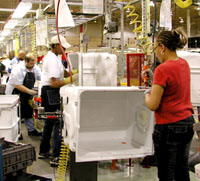
Reading Mr. Meyer’s blog, I can’t help but wonder if he’s allowed anger and personal antipathy toward Whirlpool to cloud his judgment. He seems to be confusing the issues of lean manufacturing and outsourcing.
First, senior editor Austin Weber’s article on lean manufacturing at Whirlpool was part of a series of articles written to celebrate the 100th anniversary of the company. As such, it was not the appropriate venue to dwell on the negative aspects of the company’s history, but rather to celebrate the accomplishments of one of this country’s great manufacturers.
Austin’s brilliant series took months of research, interviews and road trips. Read his fascinating recap of Whirlpool’s manufacturing historyhere.
- For a nostalgic look back at some of Whirlpool’s print advertising through the decades, click here.
- For a look at the history of Whirlpool’s dryer assembly plant in Marion, OH, click here.
- Did you know that Whirlpool has made a diverse array of products, such as air rifles, tin toys, threshing machines, lawnmowers and automobiles? Click here.
- For a brief look at some events that were occurring elsewhere in the world when Whirlpool was starting up, click here.
Even as it shuttered some U.S. manufacturing operations in recent years, Whirlpool has made a number of major investments in U.S. facilities, including:
- A new $120 million plant in Cleveland, TN, to assemble stoves and ranges.
- An $85 million investment to create a new HQ in Benton Harbor, MI.
- Acquiring a freezer assembly plant in Ottawa, OH, that belonged to now-bankrupt WC Wood, restoring 190 jobs and bringing the Whirlpool’s total employment in Ohio to approximately 10,000.
- $175 million in its laundry facilities in Ohio to produce energy- and water-efficient laundry appliances.
- $20 million in its Amana, IA, refrigerator plant to improve productivity and efficiency.
- $40 million regional distribution center in Wilmer, TX, which will be energy-efficient, LEED-certified.
The economics, the wisdom and even the ethics of Whirlpool’s decision to move some production from the United States to Mexico are certainly debatable, but the issue should be separate from whether the company has successfully adopted lean manufacturing methods and practices.
The truth is, Whirlpool has adopted lean. Maytag’s dishwasher assembly plant in Jackson, TN, was one of 12 recipients of the 2004 Shingo Prize for Excellence in Manufacturing. Dubbed the “Nobel prize of manufacturing” by Business Week magazine, the Shingo Prize is the only industrial excellence award in the world that focuses on lean manufacturing, and theMaytag plant is the first (and only) appliance manufacturing facility to receive the award.
Or, you could read my account of Whirlpool’s assembly plant in Marion, OH, where the company has devoted significant resources to getting lean, increasing efficiency, improving safety and ergonomics, reducing pollution, and decreasing the amount of waste it sends to landfills. The paint line was overhauled to accommodate a more environmentally friendly process. Engineers worked with suppliers to design plastic returnable containers for many parts, such as lint screens, wire harnesses, timers and heating elements. Assembly lines were redesigned to accommodate just-in-time inventory, kanban and point-of-use parts supplies. Read ithere.
As for the criticism that Whirlpool doesn’t tap into its people, I suggest reading “Unleashing Innovation,” written by Nancy Tennant Snyder, Whirlpool’s chief innovation officer. In her book, Snyder reveals the inner workings of Whirlpool's innovation process, a framework that consistently creates new, profitable products and features by involving all of Whirlpool’s employees. She debunks the myth that innovation comes only from the geniuses at the top. Buy ithere.
I offered this rebuttal to Mr. Meyer’s blog site, but apparently, he doesn’t want the facts to get in the way of a good story.
What do you think? Are lean and outsourcing separate issues? What are Whirlpool and other U.S. appliance manufacturers doing right? Where can they improve? Share your thoughts.

Recent Comments
Helpful for Trainees
Cable Assembly Manufacturers
Huawei for manufacturing?
should have a scanner and then 3D print the repair
IPC-A-610 and IPC-j-std-001